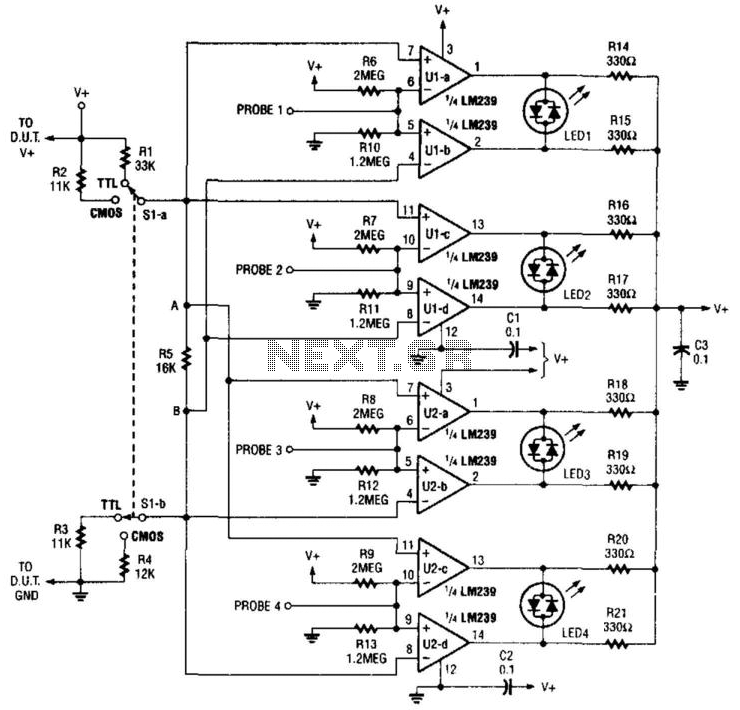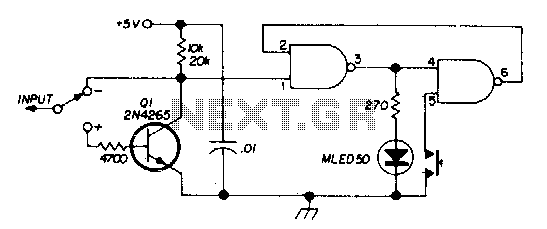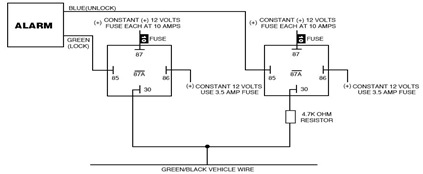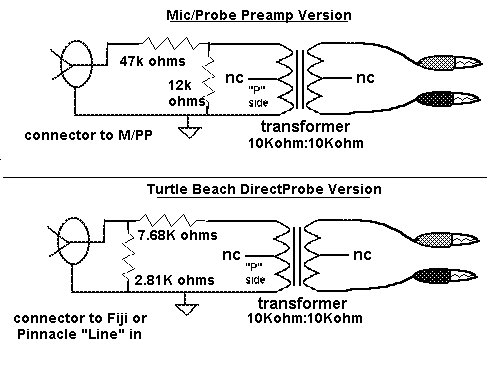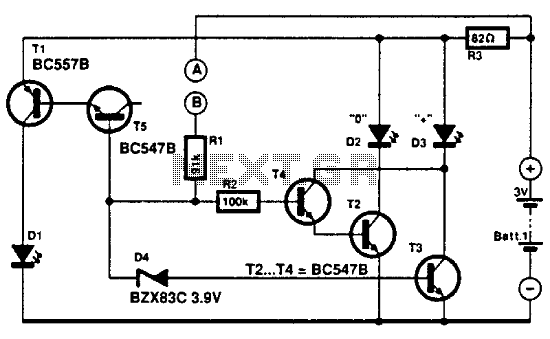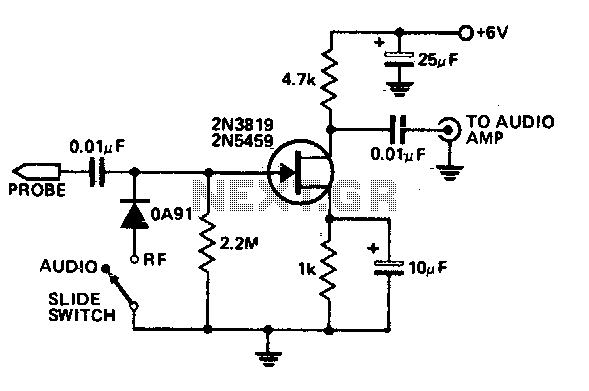
100K megohm DC probe
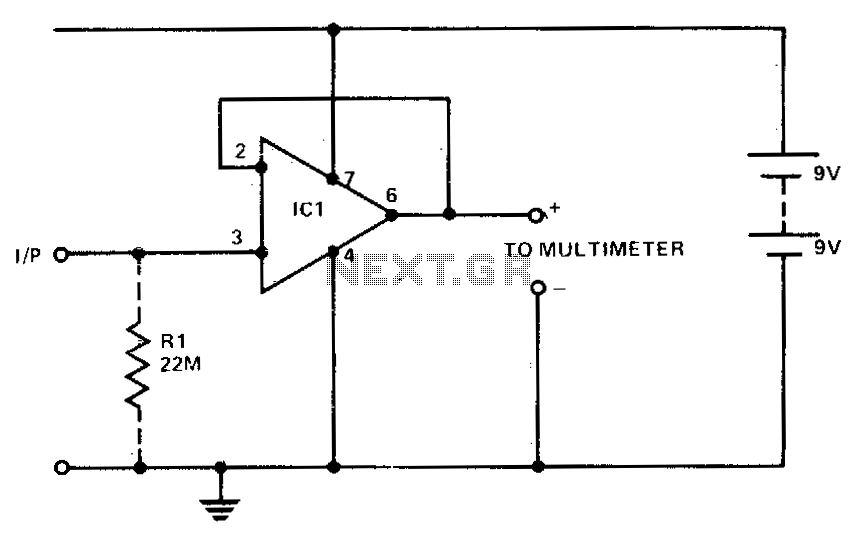
A 741 operational amplifier (op amp) is utilized with complete AC and DC feedback to achieve a typical input impedance of 10^11 ohms and unity gain. To minimize hum and radio frequency (RF) interference, it is recommended that the input leads be kept as short as possible, and the circuit should be enclosed in a small grounded case. The output leads can be longer since the output impedance of the circuit is significantly less than one ohm. In the absence of an input signal, the output level becomes indeterminate. Incorporating a load resistor (Rl) in the circuit reduces the input impedance to 22 megohms.
The 741 op amp is a widely used device in analog signal processing due to its versatility and performance characteristics. It features a differential input stage that amplifies the difference between two input voltages, resulting in high input impedance and low output impedance. The configuration with 100% feedback ensures that the op amp operates in a linear region, maintaining stability and predictable behavior.
The high input impedance of 10^11 ohms is advantageous for interfacing with high-impedance sources, as it minimizes the loading effect on the preceding stage. This characteristic is particularly useful in applications such as sensor signal conditioning, where it is critical to preserve the integrity of the signal. The unity gain configuration, also known as a voltage follower, allows the op amp to buffer the input signal, providing isolation between stages while maintaining signal fidelity.
Proper layout and grounding are essential to mitigate noise and interference. The recommendation to keep input leads short is critical in minimizing inductive and capacitive coupling that can introduce unwanted noise. A grounded enclosure further enhances the circuit's immunity to electromagnetic interference (EMI), ensuring stable operation in various environments.
The output impedance of the circuit being less than one ohm means that the op amp can drive loads without significant voltage drop, making it suitable for driving low-impedance inputs. However, it is important to note that without an input signal, the output level is indeterminate, which may lead to unpredictable behavior if the circuit is not properly biased or terminated.
When a load resistor (Rl) is introduced, it effectively modifies the input impedance to 22 megohms. This change can impact the performance of the circuit, particularly in terms of signal integrity and response time. Careful consideration of the load characteristics and the application requirements is essential to ensure optimal performance of the op amp circuit.A 741 op amp is used with 100% ac and dc feedback to provide a typical input impedance of 1011 ohm and unity gain. To avoid hum and rf pickup the input leads should be kept as short as possible and the circuit should be mounted in a small grounded case.
Output leads may be long since the output impedance of the circuit is a fraction of an ohm With no input the output level is indeterminate. Including Rl in the circuit through lowers the input impedance to 22 M.
The 741 op amp is a widely used device in analog signal processing due to its versatility and performance characteristics. It features a differential input stage that amplifies the difference between two input voltages, resulting in high input impedance and low output impedance. The configuration with 100% feedback ensures that the op amp operates in a linear region, maintaining stability and predictable behavior.
The high input impedance of 10^11 ohms is advantageous for interfacing with high-impedance sources, as it minimizes the loading effect on the preceding stage. This characteristic is particularly useful in applications such as sensor signal conditioning, where it is critical to preserve the integrity of the signal. The unity gain configuration, also known as a voltage follower, allows the op amp to buffer the input signal, providing isolation between stages while maintaining signal fidelity.
Proper layout and grounding are essential to mitigate noise and interference. The recommendation to keep input leads short is critical in minimizing inductive and capacitive coupling that can introduce unwanted noise. A grounded enclosure further enhances the circuit's immunity to electromagnetic interference (EMI), ensuring stable operation in various environments.
The output impedance of the circuit being less than one ohm means that the op amp can drive loads without significant voltage drop, making it suitable for driving low-impedance inputs. However, it is important to note that without an input signal, the output level is indeterminate, which may lead to unpredictable behavior if the circuit is not properly biased or terminated.
When a load resistor (Rl) is introduced, it effectively modifies the input impedance to 22 megohms. This change can impact the performance of the circuit, particularly in terms of signal integrity and response time. Careful consideration of the load characteristics and the application requirements is essential to ensure optimal performance of the op amp circuit.A 741 op amp is used with 100% ac and dc feedback to provide a typical input impedance of 1011 ohm and unity gain. To avoid hum and rf pickup the input leads should be kept as short as possible and the circuit should be mounted in a small grounded case.
Output leads may be long since the output impedance of the circuit is a fraction of an ohm With no input the output level is indeterminate. Including Rl in the circuit through lowers the input impedance to 22 M.
